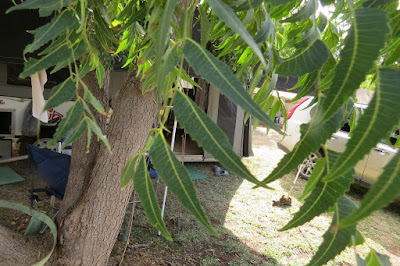A friend from Toowong Bridge Club, Elizabeth Macintosh, suggested we visit her daughter's property, 'Fairfield', 27 km north of Longreach on the Muttaburra Road. We left 'Noonbah' on 4/7 and drove 2 hours to Longreach, seeing emus and this beautiful Black-headed Python on the road near Bimerah.
 |
| A long snake! |
After shopping, lunch and a haircut for me in Longreach, we reached 'Fairfield' around 4pm. Our hosts, Robert and Margot Macintosh, are delightful people with equally lovely adult children. A very different property to 'Noonbah' - sheep, no cattle now, grasslands with artesian bore drains.
Barry & Marjorie Jahnke stayed near the homestead because of their caravan; Peter & Lynette Haselgrove accompanied us as we followed the Macintosh vehicle to a very nice campsite next to the Thomson River. It was dark by the time we set up but we enjoyed the lovely trees and comparative absence of prickles in the grass. Rain fell as we drove the 5km track and our rig was very muddy.
 |
| Coolabahs at camp |
 |
| Boot tree | |
Next day we walked beside the river to a waterhole used by the
family and others, with rope swing and pebbly beach.
 |
| Swimming hole |
 |
| Pebbly beach |
 |
| Parkinsonia aculeata, weed species |
Saw many birds
including Spotted Pardalote, Little Woodswallow, Spiny-cheeked
Honeyeater, Black-fronted Dotterels, White-plumed Honeyeaters and
Peaceful Doves.
 |
| Spotted Bowerbird |
 |
| Little Woodswallow |
 |
| Looking at you |
 |
| Saw the Dotterels near these Melaleucas |
 |
| Bauhinia gilvum | | | |
 |
| Bauhinia gilvum leaves |
On Thursday we followed a Macintosh map of the property featuring bores, fossils, dams. All very interesting.
Barry sampled the water in the bore drain and found gambusia.
DAF (Dept of Agriculture and Fisheries) says:
Gambusia were first introduced into Australia from North America as a
biological control for mosquitoes; however, this was unsuccessful.
Instead,
they have had a detrimental effect on native fish through competition
for resources and their aggressive behaviour. They have a habit of
nipping the fins of other fish, regardless of size differences. They
also prey on the eggs and larvae of native fish and frogs....poisons
have been used to eradicate pest fish in ponds and small dams, but are
not practical for rivers and streams as these poisons also kill native
fish.

 |
| Peter checks temperature of bore water - HOT |
 |
| For his next performance, Peter cuts high tensile fencing wire from our tail shaft - thank you, Peter! |
We stopped at the fossil dam for lunch under some shady trees.
 |
| Lunch spot |
 |
| Devil's claw |
 |
| Sheep, including twin lambs, departing when we arrived |
 |
| Shearing shed |
Margot and Robert invited us all to dinner that night. We met their lovely daughters Amy (who cooked the main course) and Mary. It was a most enjoyable evening with plenty of interesting conversation. Robert is passionate and knowledgeable about sheep breeding and management but also an entertaining musician, playing accordion and piano that night. Amy also played piano and Peter borrowed a guitar to join in, having left his fiddle in the trailer.
Unfortunately, rain fell all that night so we waited until 3pm for the track, including 2 gullies, to dry enough for safe exit.
 |
| David is happy to find that the steepest bit had dried |
|
|
 |
| Track out of 'Fairfield' |
The road back to Longreach was not so obliging, greasy and slippery so the EPS light came on as the car corrected for stability.
The car was running at 3000 revs all 27km to Longreach.
We had to accept an unpowered site at Longreach and I was not happy to find that no washing machine was available - 3 out of order and 2 in use. Brolgas were the only attractive sight in the park.
We intended to visit 'Age of Dinosaurs' again at Winton and stay there 2 nights but the only option was a site in Matilda CP which had dreadful amenities. So we contacted Cloncurry Oasis CP and booked 2 nights there, giving us a 528 km trip. No road kill to Winton as rail on one side, both sides fenced. Altitude at Winton was 170m (250m Longreach) - now in Lake Eyre Basin.
Our fuel consumption was 10.9l/100km. 250km from Cloncurry, some interesting hills, many covered with green trees, soon becoming bare paddocks.
Saw a flock of budgies just north of Kynuna, 173 km to Cloncurry.
Very glad to get a shady site on grass, near amenities with good washing machines.
 |
| Grey-crowned Babblers |
We stayed there 3 nights to rest, despite increasingly crowded park. Good to have time to bake a cake, go shopping. Sunny, windy in Cloncurry - could dry a load on the line in an hour. Birds throughout park - apostle birds, crested pigeons, magpie-larks, galahs, grey-crowned babblers, yellow-throated miners. Near the dry river I saw varied lorikeets, whistling kite, sparrow, magpie.
 |
| Whistling Kite |
 |
| This caught David's attention at Cloncurry Information Centre |
The next day we visited Chinaman Dam at 4pm but too windy for most birds. Saw little grebe,
BIG cormorant ( I think Great Cormorant as mostly black with some white near/on head), pelican, willie wagtail, Caspian tern, black kite.

 |
| Unofficial unoccupied camp |
 |
| Australasian Grebe | | | | | | | | | | | | |
|
 |
| Melaleuca roots exposed | | | | | | | | | |
| | |
|
|
|






















































No comments:
Post a Comment